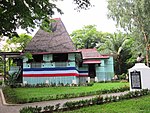Santa Mesa station

Santa Mesa station is a railway station located on the South Main Line in the city of Manila, Philippines. It is one of two stations (the other is Pasay Road) in the line to have its own access road. The station is the fourth station southbound from Tutuban and is the only railway station serving Santa Mesa. In addition to having its own dedicated access road, Santa Mesa station is also one of three stations (the others being Pasay Road and España) to have its original platforms extended and raised in order to accommodate new PNR diesel multiple units. The original platforms have been retained for the use of Commuter Express locomotives and especially for intercity trains, although Santa Mesa is not designated as a station where these trains can stop. The station used to serve the Santa Mesa-Mandaluyong branch line, also known as Guadalupe line, which used to run up to Antipolo and Montalban. This line has since been dismantled.
Excerpt from the Wikipedia article Santa Mesa station (License: CC BY-SA 3.0, Authors, Images).Santa Mesa station
NLEX-SLEX Connector Road, Manila Santa Mesa (Sixth District)
Geographical coordinates (GPS) Address Nearby Places Show on map
Geographical coordinates (GPS)
| Latitude | Longitude |
|---|---|
| N 14.600761111111 ° | E 121.01034722222 ° |
Address
Santa Mesa
NLEX-SLEX Connector Road
1016 Manila, Santa Mesa (Sixth District)
Philippines
Open on Google Maps






